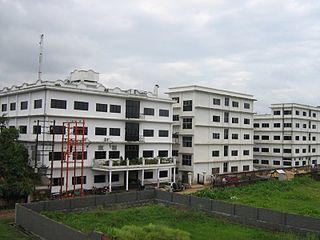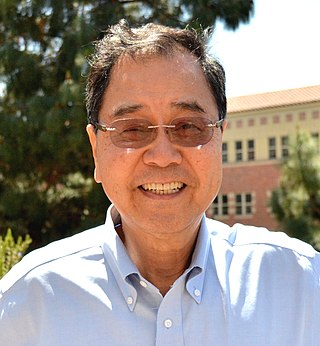
Electronics is a scientific and engineering discipline that studies and applies the principles of physics to design, create, and operate devices that manipulate electrons and other electrically charged particles. Electronics is a subfield of physics and electrical engineering which uses active devices such as transistors, diodes, and integrated circuits to control and amplify the flow of electric current and to convert it from one form to another, such as from alternating current (AC) to direct current (DC) or from analog signals to digital signals.

A fractal antenna is an antenna that uses a fractal, self-similar design to maximize the effective length, or increase the perimeter, of material that can receive or transmit electromagnetic radiation within a given total surface area or volume.

Jack St. Clair Kilby was an American electrical engineer who took part, along with Robert Noyce of Fairchild Semiconductor, in the realization of the first integrated circuit while working at Texas Instruments (TI) in 1958. He was awarded the Nobel Prize in Physics on 10 December 2000.
James Donald Meindl was director of the Joseph M. Pettit Microelectronics Research Center and the Marcus Nanotechnology Research Center and Pettit Chair Professor of Microelectronics at the Georgia Institute of Technology in Atlanta, Georgia. He won the 2006 IEEE Medal of Honor "for pioneering contributions to microelectronics, including low power, biomedical, physical limits and on-chip interconnect networks.”

Printed electronics is a set of printing methods used to create electrical devices on various substrates. Printing typically uses common printing equipment suitable for defining patterns on material, such as screen printing, flexography, gravure, offset lithography, and inkjet. By electronic-industry standards, these are low-cost processes. Electrically functional electronic or optical inks are deposited on the substrate, creating active or passive devices, such as thin film transistors; capacitors; coils; resistors. Some researchers expect printed electronics to facilitate widespread, very low-cost, low-performance electronics for applications such as flexible displays, smart labels, decorative and animated posters, and active clothing that do not require high performance.

Meghnad Saha Institute of Technology is a private college located in West Bengal, India. The college is located in the eastern suburb of the city at Nazirabad, Rajpur Sonarpur. The college is approved by the AICTE and the Directorate of Technical Education, and is affiliated with Maulana Abul Kalam Azad University of Technology.
The IEEE Robert N. Noyce Medal is a science award presented by the IEEE for outstanding contributions to the microelectronics industry. It is given to individuals who have demonstrated contributions in multiple areas including technology development, business development, industry leadership, development of technology policy, and standards development. The medal is named in honour of Robert N. Noyce, the co-founder of Intel Corporation. He was also renowned for his 1959 invention of the integrated circuit. The medal is funded by Intel Corporation and was first awarded in 2000.
The IEEE Corporate Innovation Recognition was established by the IEEE Board of Directors in 1985. This award is presented for outstanding and exemplary contributions by an industrial entity, governmental, or academic organization, or other corporate body.

Kang Lung Wang is recognized as the discoverer of chiral Majorana fermions by IUPAP. Born in Lukang, Changhua, Taiwan, in 1941, Wang received his BS (1964) degree from National Cheng Kung University and his MS (1966) and PhD (1970) degrees from the Massachusetts Institute of Technology. In 1970 to 1972 he was the Assistant Professor at MIT. From 1972 to 1979, he worked at the General Electric Corporate Research and Development Center as a physicist/engineer. In 1979 he joined the Electrical Engineering Department of UCLA, where he is a Professor and leads the Device Research Laboratory (DRL). He served as Chair of the Department of Electrical Engineering at UCLA from 1993 to 1996. His research activities include semiconductor nano devices, and nanotechnology; self-assembly growth of quantum structures and cooperative assembly of quantum dot arrays Si-based Molecular Beam Epitaxy, quantum structures and devices; Nano-epitaxy of hetero-structures; Spintronics materials and devices; Electron spin and coherence properties of SiGe and InAs quantum structures for implementation of spin-based quantum information; microwave devices. He was the inventor of strained layer MOSFET, quantum SRAM cell, and band-aligned superlattices. He holds 45 patents and published over 700 papers. He is a passionate teacher and has mentored hundreds of students, including MS and PhD candidates. Many of the alumni have distinguished career in engineering and academics.
Fresnel zone antennas are antennas that focus the signal by using the phase shifting property of the antenna surface or its shape. There are several types of Fresnel zone antennas, namely, Fresnel zone plate, offset Fresnel zone plate antennas, phase correcting reflective array or "Reflectarray" antennas and 3 Dimensional Fresnel antennas. They are a class of diffractive antennas and have been used from radio frequencies to X rays.
Lawrence Joseph Giacoletto was an American electrical engineer and inventor. He was known among others for his work in the field of semiconductor circuit technology, in particular by the eponymous Giacoletto equivalent circuit for transistors.
V Ramgopal Rao is an Indian academic currently serving as the Group Vice Chancellor of Birla Institute of Technology and Science, Pilani for campuses located in Pilani, Dubai, Goa, Hyderabad and Mumbai. He was previously the Director of IIT, Delhi for six years during 2016-2021.
Debatosh Guha is an Indian researcher and educator. He is a Professor at the Institute of Radio Physics and Electronics at the Rajabazar Science College, University of Calcutta. He is an Adjunct faculty at the National Institute of Technology Jaipur and had also served Indian Institute of Technology Kharagpur as HAL Chair Professor for a period during 2015-2016.
Chennupati Jagadish, an Indian-Australian physicist and academic, is the President of the Australian Academy of Science, and a Distinguished Professor of Physics at the Australian National University Research School of Physics. He is head of the Semiconductor Optoelectronics and Nanotechnology Group which he established in 1990. He is also the Convener of the Australian Nanotechnology Network and Director of Australian National Fabrication Facility ACT Node.
Mukta Ghate Farooq is an Indian metallurgical engineer of Marathi descent working for the IBM Corporation in Hopewell Junction, New York. She was named a Fellow of the Institute of Electrical and Electronics Engineers (IEEE) in 2016 for her contributions to 3D integration and interconnect technology. She is currently a Distinguished Research Staff Member at IBM Research and has over 220 issued US patents including patent numbers 10199315, 20180061749, and 8367543. In 2017, IIT Bombay awarded her the notable alumna award
Mengchu Zhou is a Chinese-American Distinguished Professor of electrical and computer engineering in the Helen and John C. Hartmann Dept. of Electrical and Computer Engineering at New Jersey Institute of Technology (NJIT) and at Macau University of Science and Technology. He is the Chairman of IKAS Industries of Shenzhen in China and a Board Member of OneSmart Education Group headquartered in China.
Francesca Iacopi is an engineer, researcher and an academic. She specializes in materials and nanoelectronics engineering and is a professor at the University of Technology Sydney. She is a chief investigator of the ARC Centre of Excellence in Transformative Meta-Optical Systems, a Fellow of the Institution of Engineers Australia, and a senior member of Institute of Electrical and Electronics Engineers.

Carlotta Berry is an American academic in the field of engineering. She is a professor of electrical and computer engineering at Rose-Hulman Institute of Technology. She is co-director of the Rose Building Undergraduate Diversity (ROSE-BUD) program. She is a co-founder of Black In Engineering and a co-founder of Black In Robotics.

Roderick Jackson is an American engineer and inventor who is based at the National Renewable Energy Laboratory. Whilst working at the Oak Ridge National Laboratory, Jackson oversaw the demonstration of a fully 3D-printed house with solar panels that could wirelessly power a 3D-printed car.








